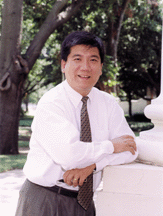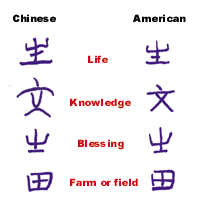|
Articles:
Unconventional life
| A brave new world

Brave new world
Mike Xu, assistant professor of Chinese, has a theory -- and evidence -- that may change everything we know about ancient Americans.

By David Van Meter
 Assistant Professor Mike Xu feels Copernicus' pain. Assistant Professor Mike Xu feels Copernicus' pain.
Remember, the latter told the world's experts in 1513 that the sun rather than the Earth was the center of the solar system. Hah, even Galileo disagreed.
Xu, in his second year of teaching the Chinese language and culture at TCU, has similar problems. The thoughtful Xu sits in the Faculty Center in Reed Hall and quietly recalls the ruckus he has caused among those who study Mesoamerica's "mother culture," the first organized society from which Native Americans come.
Xu's idea concerns the Olmec, the first civilized people to emerge in Mesoamerica, which includes Mexico, Guatemala, Belize, El Salvador and parts of Honduras, Costa Rica and the southwestern United States. From that group 3,200 years ago came the Mayans and the Aztecs.
A Yale anthropologist called Xu's notion an insult to the entire region.
A Princeton archaeologist termed it rubbish.
Until two years ago, researchers in China wouldn't even look at what Xu had to show.
Yet, a growing number of others -- including Shang experts from the China National Academy of Social Sciences and research archaeologist Betty Meggers from the Smithsonian -- strongly support what Xu has unearthed. "His evidence," she said, "opens up a whole new door . . . "
Indeed, the idea alone breaks it down:
What if the ancient Chinese came across the Pacific to the New World more than 3,000 years ago?
If you just spilled your coffee, you're not the first, even among those who regulary venture into American history that predates Christopher Columbus.
Five years ago, Xu happened upon an Olmec exhibit in Mexico and noticed markings inscribed into many of the pieces. Though he was no expert in the ancient pieces of pottery, jade or carved bones, the Shanghai native knew what he saw.
"I said to myself, 'I am certain what I see; these look like Chinese characters.' "
Archaeologists place the abrupt emergence of the Olmec era between 1200-1100 B.C, around the fall of the Shang dynasty in China. Xu compared the symbols he saw with inscriptions on pieces from the Shang period. The markings were nearly identical, not to mention both cultures used similar sacrificial altars and worshipped jade.
Xu first tried to pass along his discovery to someone in the field. Unsuccessful, he traveled to Beijing and showed the characters he had collected to scores of Shang experts.
"They asked me where I had found them in China," Xu said. "I told them, "No, not China --
Meso- america. They thought the symbols were Chinese characters, too."
Xu is fast becoming integral in what is emerging as a new field of trans-Pacific studies. This past summer, Xu was invited to present more than 300 characters at an international symposium of
jiaguwen, the oldest Chinese characters. In September, Xu's work was published across 16 pages of China's most influential academic journal, the Quarterly Journal of the Shanghai Academy of Social Sciences, as well as in The Chicago Sun-Times, U.S. News & World Report, Discovery Channel, ABC News and National Geographic News.
The real question now might be: How did the ancient Chinese arrive in America in the first place? Xu immediately discounts the land bridge, that stretch of land which spanned the Bering Strait about 12,000 years ago.
"The land bridge was not there 3,000 years ago; it was gone by then," he said. "They must have crossed by boat."
Underwater pyramids discovered off the coast of Japan in 1995 indicate that sea levels were lower at some point, which would have provided islands to help ancient mariners make the long journey.
"The Pacific Ocean means 'peaceful ocean,' " Xu said. There are many stories in ancient America about 'crossing the big ocean by jumping stones.' " Xu adds that even today there is a current that meanders its way to the Americas.
All that remains to be proven, but for now Copernicus probably looks on with interest from afar.
"The origin of the mother culture on this continent is a mystery," Xu said. "And though we may not have cracked that mystery, at least we have opened another door.
"Sometimes, we look at everything we know and we can't find the answer. Then we turn around and it is there."
Top
|



